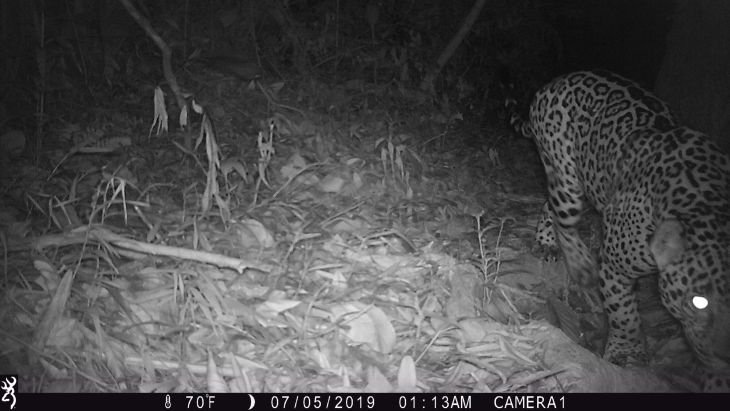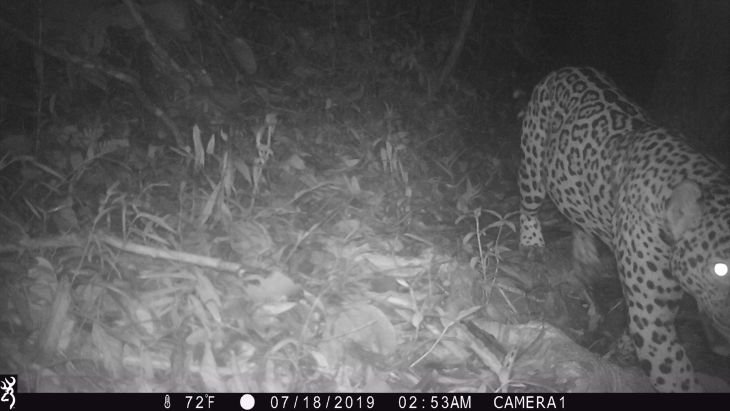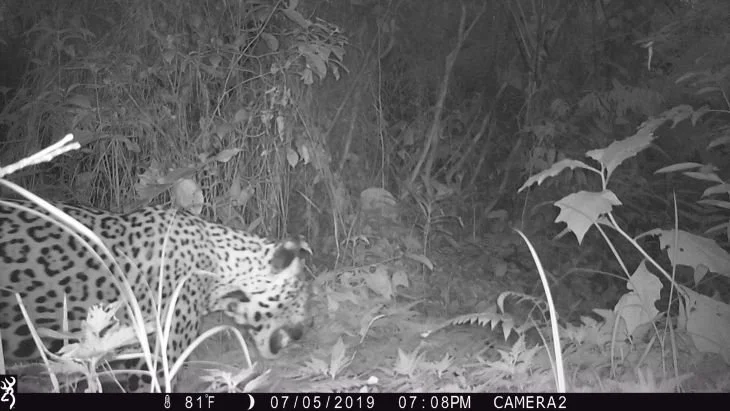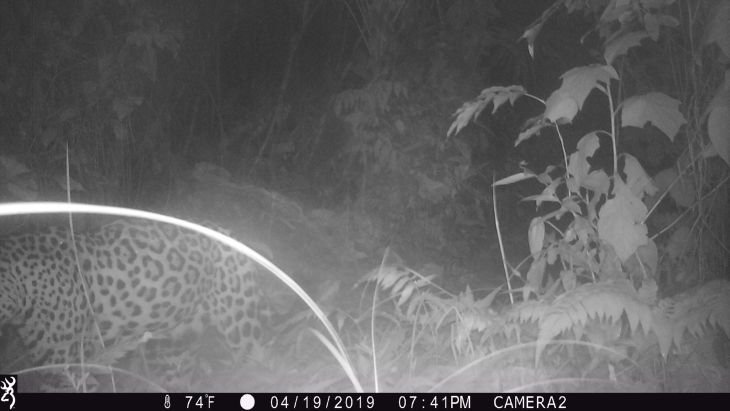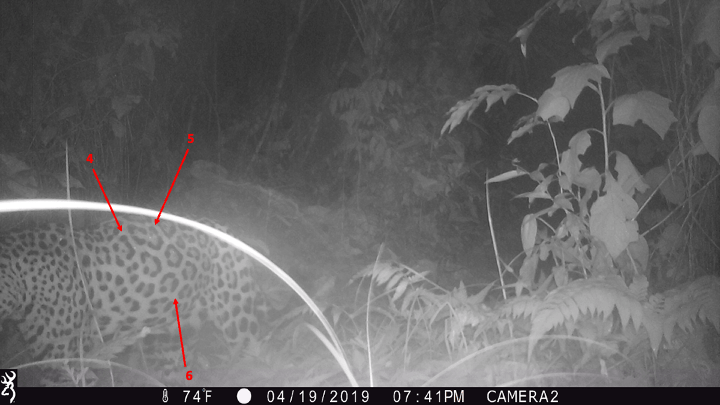Learn about Jaguar Spot Identification from the Jaguars of Sleeping Giant
How are jaguars identified?
Since 2017, Inspire EdVentures has operated five trail cameras in the rainforest near the Sleeping Giant Lodge in Belize. These trail cameras are an unobtrusive way to observe wildlife. They are mounted on trees near existing animal paths or clearings and set to take a sequence of photos when detecting movement. This movement is not always an animal; we have many photos of falling leaves or even heavy rainstorms! Over the past five years, we have collected thousands of photos showing at least 18 separate species, from birds to small mammals, to Belize’s largest predator, the jaguar.
Jaguars, the largest wild cats found in North and South America, seem to stand out with their beautiful, richly spotted fur. However, these spots, or rosettes, actually have the opposite effect in the wild. They help camouflage jaguars from their prey while moving through the rainforest.
Rosette sizes and shapes vary across the jaguar’s coats. On the back and sides, rosettes are typically larger and consist of a dark, roughly rounded outline, with a solid dot or dots inside. Spots on the head, shoulders, legs, and underbelly tend to be smaller and solid black. Black jaguars, sometimes known as black panthers (a name they share with melanistic black leopards), are jaguars with a rare condition known as melanism, which results in a much darker coat. Though these jaguars may seem to be completely black, they have spots just the same as other jaguars; they’re simply more difficult to see.
A close-up of a jaguar at the Belize Zoo, showing the pattern of spots, or rosettes, across its fur. Image © Inspire EdVentures.
Though they may seem similar from a distance, each jaguar has a completely unique pattern of rosettes. Scientists, researchers, and others can use these patterns to identify and even track individual jaguars. At Inspire EdVentures, we have used our trail camera photos to do the same.
Identifying a Jaguar
One struggle of jaguar identification is that we rarely see a jaguar from the same angle twice. However, in July 2019, Camera 1 captured the following two photos, around two weeks apart:
We identified the following spots on the first picture: 1) a rosette with two dots inside; 2) an irregularly shaped rosette; and 3) an hourglass-shaped rosette.
In the second picture, we can identify the same shapes:
These photos are of the same jaguar!
The Sleeping Giant Jaguar
When originally building this article, my intention was to present a photo of a different jaguar from a similar angle, showing how the rosette pattern differs across different animals. However, I soon ran into a problem: I was unable to find a jaguar, viewed from the right angle, that did not match this pattern. In other words, almost every photo of a jaguar recorded by our trail cameras seems to be of the same animal.
Our earliest photo from this angle, taken in June 2019, shows the same spot pattern (though slightly blurrier): 1) a rosette with two dots inside; 2) an irregularly shaped rosette; and 3) and an hourglass-shaped rosette. We can additionally identify a rosette with three dots inside, which will help us examine later photos.
Notably, this photo was taken by Camera 4, not Camera 1. Between June 30 2019 and July 3 2019, this jaguar crossed from the Camera 1 area into the Camera 4 area.
So where did our jaguar go next?
Camera 2 captures the same jaguar, now identified by markings 2, 3, and 4, as marking 1 is obscured by the angle, on July 5 2019. This is the same day as our first photo! Looking at the timestamps, we can see that the jaguar began the day near Camera 1 (at 1:13 AM) and ended the day near Camera 2 (at 7:08 PM).
A week later, the jaguar returns to Camera 1 (image previously shown), and, just over a week after that, the jaguar returns to Camera 2.
Our next identifiable photo is from Camera 4, on January 11 2020.
Though these are again slightly blurry, we are able to identify the shape of the rosettes, showing that this is the same jaguar.
Finally, we see the jaguar in July 2020, on Camera 2, at 12:38 AM.
Continuing Identification
We’ve identified at least seven pictures of our jaguar, but only from one side. How do we know if we’ve seen the same jaguar from a different angle?
One hint may be a photo from Camera 2 showing a jaguar from the left side:
This photo was taken by Camera 2 on July 5 2019, the same date as two photos identified above: one taken by Camera 1 at 1:13 AM, and one taken by Camera 2 at 7:08 PM.
Could this be the same jaguar?
This is a difficult question to answer. Jaguars are largely solitary, but their territories can overlap, especially between males and females of the species. That is, a male’s territory will be distinct from another male’s, but may overlap with the territories of one or more females.
Because we only see these jaguars from one side at a time, we can’t match the spots identified in the above section with the spots seen in our new picture. However, we can identify new distinct rosettes: 1) a rosette with four dots inside; 2) an irregular rectangular rosette; and 3) a more circular rosette with one dot inside.
We can identify this jaguar in a photo taken by Camera 5 on August 20 2019:
Another photo from a similar angle, taken on July 13 2020 by Camera 5, can be matched to the same pattern:
This jaguar seems to have remained in, or repeatedly visited, the area. Though difficult to be certain, it is very possible that this is the same jaguar previously identified from the right side.
Identifying Other Jaguars
We know there was at least one other jaguar in the area in 2019. This photo was taken by Camera 2 on April 19 2019:
Let’s compare this image with one of our previously identified jaguar:
Our new jaguar shows a pattern of spots, including 4) a large rosette with a dot inside; 5) an irregularly heart-shaped rosette; and 6) a cluster of three similarly-shaped rosettes that is inconsistent with our previously identified pattern. This is a different jaguar! It is also the only image we can identify with this spot pattern; we have not seen this jaguar, or at least we have not seen this jaguar from the same angle, since this photo was taken.
From this, we can conclude that there were at least two, and possibly three, jaguars in the area around the Sleeping Giant rainforest between 2019 and 2020.
What Next?
Inspire EdVentures continues to gather pictures and information from our trail cameras. Though travel to Belize was briefly interrupted in 2020 and 2021 due to the COVID-19 pandemic and travel restrictions, we hope to resume our work with trail cameras very soon, and to continue our work in jaguar identification. Keep an eye on our website and subscribe to our newsletter for any upcoming jaguar news!
Kayla is a biologist and science writer specializing in ecology and conservation. She is a graduate from North Carolina State University and project manager for Inspire EdVentures since 2020.
All photos are the property of Inspire EdVentures and may not be used without permission.


